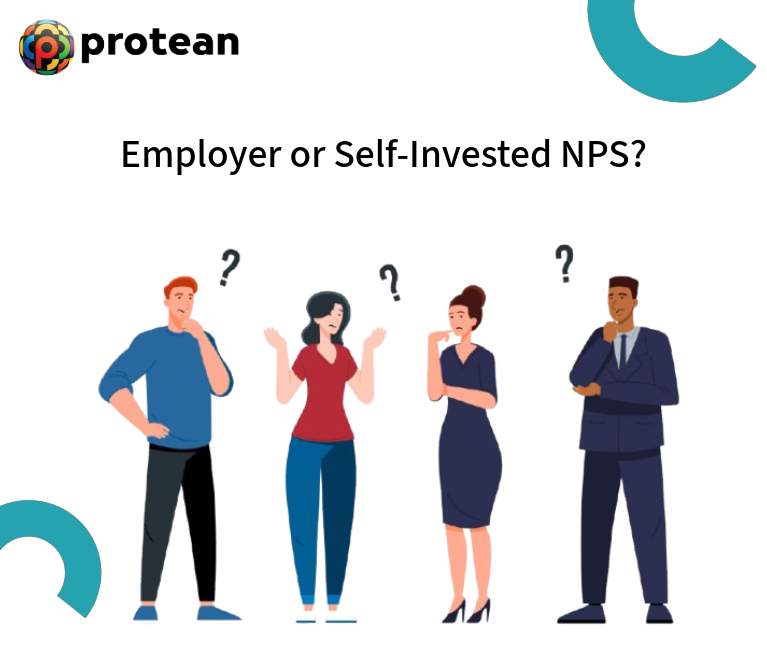What type of NPS investment is for me?
Should I choose employer contribution to NPS for retirement planning or make self-investment?
Let us find out!
The National Pension System or NPS investment has emerged as a powerful long-term retirement planning tool for Indian citizens. It can offer a mix of:
- Market-linked returns
- Disciplined savings
- Tax benefits
- Steady retirement planning
There are two main avenues to invest in NPS:
- Employer contribution (corporate NPS)
- Self-investment (individual NPS).
Salaried employees may benefit from their employer’s contribution to their NPS account.
Additionally, they also have the option to voluntarily contribute more through self-investment. Both methods offer distinct advantages depending on one's income level, tax liabilities, and retirement goals.
Let us learn more about these NPS investment options for salaried employees.
Difference Between Corporate (Employer) NPS and Individual (Self) NPS
With the corporate (employer) NPS model, organisations can open NPS accounts for their employees. They can make employer contribution to NPS directly to their Tier I accounts. These contributions can be a fixed percentage of the employee’s basic salary plus dearness allowance (DA). Employees benefit from an additional tax deduction of up to ₹50,000 over and above the ₹1.5 lakh limit under Section 80C.
On the other hand, individual (self) NPS accounts can be opened and funded independently by subscribers without employer involvement. These accounts can offer flexibility in terms of contribution amount and frequency.
Both the NPS investment account types fall under the NPS Tier I structure. These are for retirement planning and have NPS tax benefits, and partial withdrawals (EET regime).
How Employer Contribution to NPS Works
In the employer-based NPS investment model, organisations can contribute directly to an employee’s Tier I NPS account.
The standard practice is for private sector employers to contribute up to 10% of the employee’s Basic + DA, while central and state governments contribute up to 14%.
This contribution is exempt from taxable income under Section 80CCD(2) of the Income Tax Act, without any monetary ceiling, though the overall tax-free limit is ₹7.5 lakh when combined with other retirement benefits like provident fund and gratuity.
Employer contribution to NPS can offer additional tax savings beyond the ₹1.5 lakh Section 80C limit. This can support the following:
- Disciplined retirement savings
- Market-linked growth
- Professionally managed investments regulated by PFRDA.
How Self-Contribution in NPS Investment Works
These are individual contributions made voluntarily by the subscriber, whether or not they have employer participation.
Any Indian citizen between 18 and 70 years of age can open a Tier I NPS account through the CRA platforms or via registered banks and fintech portals.
Contributions under self-investment are eligible for NPS tax benefits under two sections:
- Section 80CCD(1): For contributions up to 10% of salary (Basic + DA) for salaried individuals or 20% of gross income for self-employed individuals, within the overall ₹1.5 lakh limit under Section 80C.
- Section 80CCD(1B): An additional deduction of ₹50,000 is available exclusively for NPS, over and above the ₹1.5 lakh limit.
Thus, with self-investing in NPS, individuals can claim up to ₹2 lakh in tax benefits annually.
Importantly, the self-investment route can provide flexibility in terms of:
- Amount
- Frequency
- Timing.
Subscribers can choose to contribute monthly, quarterly, or lump sum based on cash flow.
This option can be better for:
- Individuals whose employers do not offer employer contribution to NPS.
- Salaried employees who want to invest beyond the employer contribution.
- Taxpayers in the 30% bracket, who are looking for higher deductions.
- Those targeting inflation-adjusted retirement returns with equity-debt exposure (through Active or Auto choice asset allocations).
Tax Benefits: Employer vs. Self-Investment
The following table has shown the difference between NPS tax benefits for salaried employees and NPS investment self-contribution:

Pros: Employer Contribution vs. Self-Investment

- Employer contribution can offer ease and extra tax benefits, though it depends on salary structure and employer policy.
- Self-investment can provide flexibility and control. This can be better for exceeding employer limits or irregular contributions.
- You can maximise tax savings and boost long-term retirement planning, by combining both.
Main Considerations Before Choosing
Before deciding between employer contribution and self-investment in NPS, you can assess your income level, tax bracket, job stability, investment horizon, and existing retirement plans such as EPF, PPF, or mutual funds.
If your employer is offering NPS, you should not miss the 80CCD(2) tax benefit. If not, or if you are aiming for maximum tax efficiency, you can use the 80CCD(1B) route to claim an additional ₹50,000 deduction.
You can also consider your liquidity needs. NPS investment is a long-term instrument with restricted withdrawal. Therefore, making NPS investments for short-term goals might not help.
Conclusion
NPS investment can be a robust tool for tax-efficient retirement planning. While employer contributions can offer simplicity and an additional tax edge, self-investment can give you control and flexibility to enhance your retirement corpus. Both can have their own advantages, and in most cases, a combination of the two might help you yield better potential in NPS returns and retirement planning.
Frequently Asked Quetsions
Q1: Can I avail both employer contribution and self-investment benefits in NPS?
Yes. You can benefit from both. Employer contributions fall under Section 80CCD(2), while self-contributions fall under Section 80CCD(1) and 80CCD(1B).
Q2: What happens to my employer NPS account if I switch jobs?
Your NPS account remains the same (based on PRAN). You can port the same account to a new employer or continue investing as an individual.
Q3: Can I change my pension fund manager or asset allocation later?
Yes. PFRDA allows subscribers to switch fund managers and asset allocations once or twice a year.
Q4: Are NPS returns guaranteed?
No. NPS can offer potential market-linked returns. NPS returns aren’t guaranteed and depend on the returns of the underlying asset classes.
Q5: Can I withdraw NPS before retirement?
Partial withdrawal (up to 25%) is allowed after 3 years for specific purposes. Full withdrawal is permitted at 60, with 60% tax-free and 40% used for annuity.

